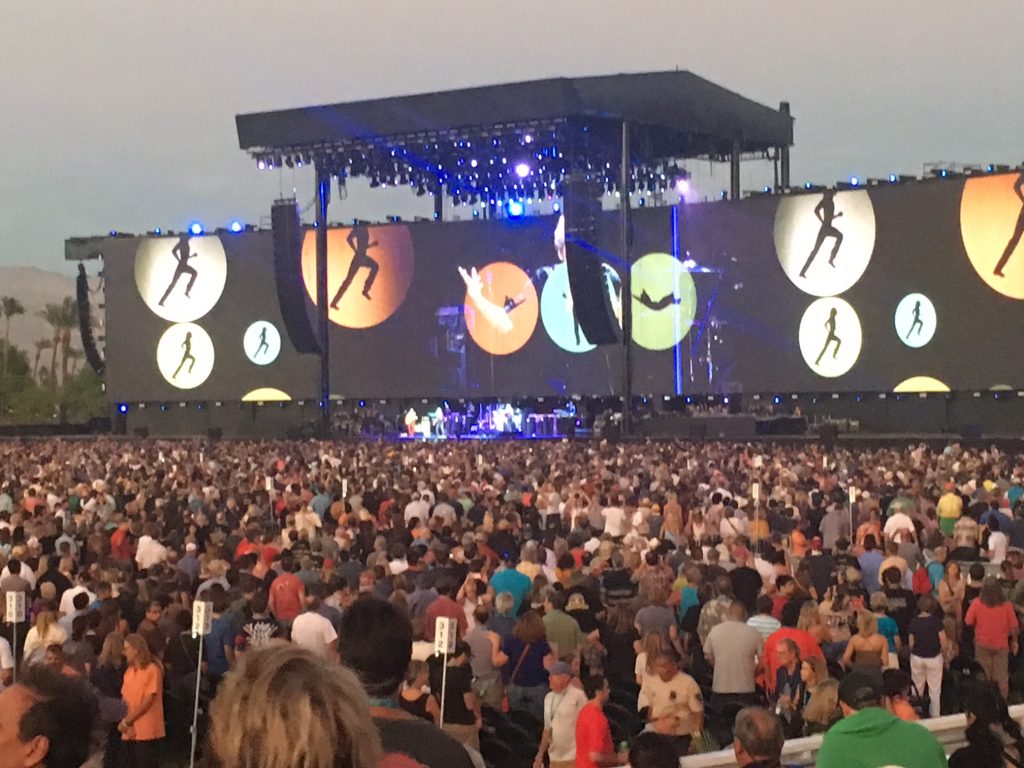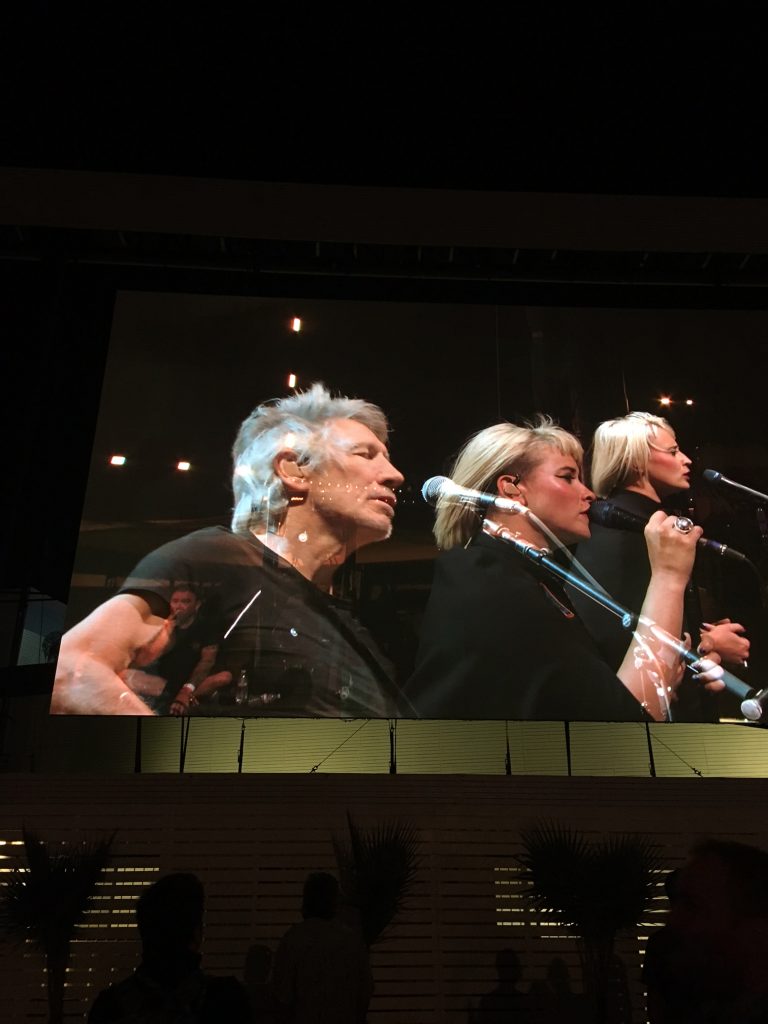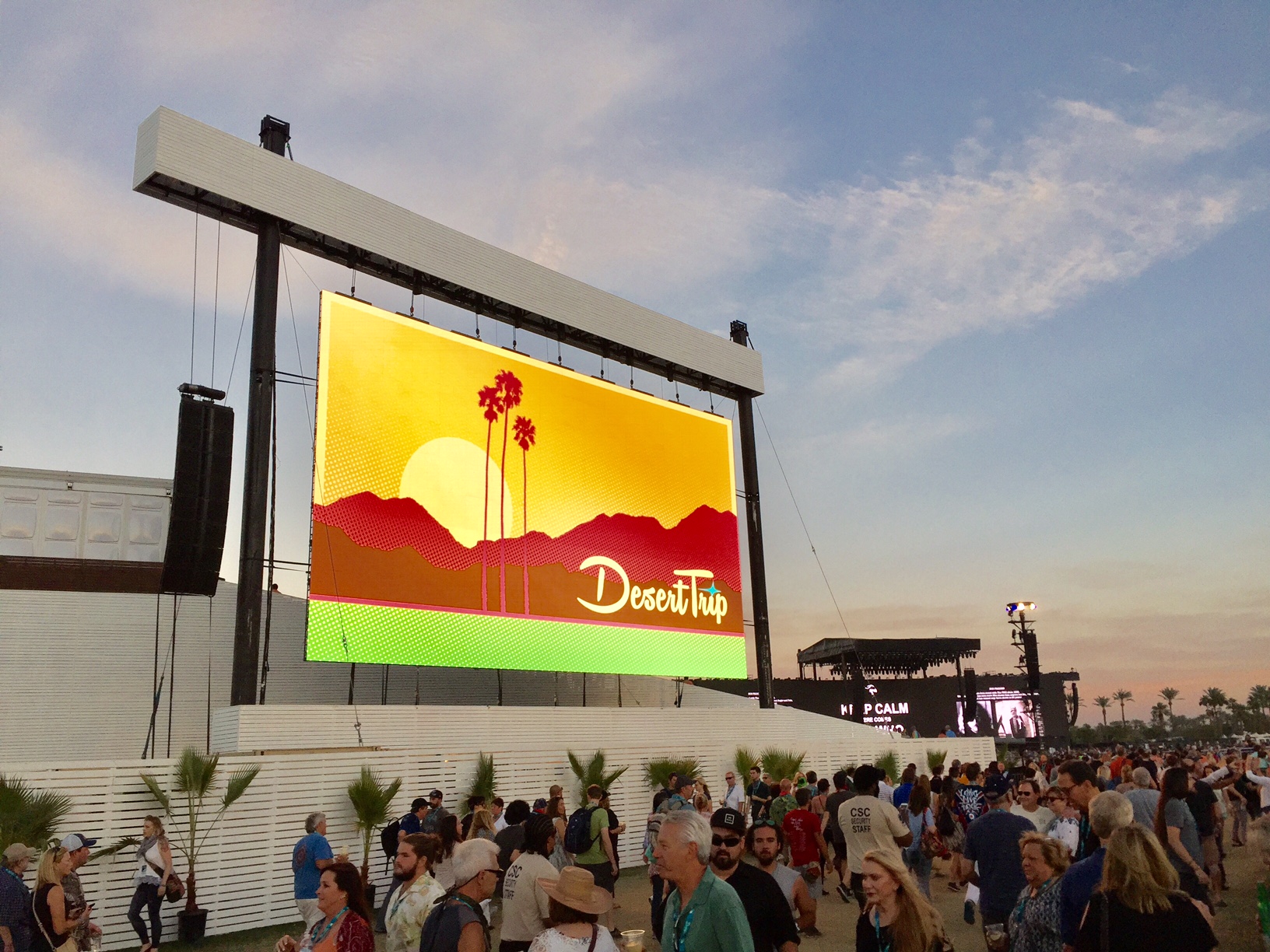Desert Trip brings out best in veteran rockers
When Joni Mitchell wrote about Woodstock on her 1970’s album Ladies of the Canyon, she described starry-eyed children of god walking out to upstate New York to join rock and roll bands, camp out on the land and set their soul free.
Less than 50 years later, if she were to write a similar song about the past two weekends in Indio, California, she’d probably have to mention chartered buses, brightly lit restrooms and stringent rules surrounding color-coded RFID implanted wristbands in order to accurately capture the spirit.
When it was announced that Bob Dylan, the Rolling Stones, Neil Young, Paul McCartney, the Who and Roger Waters would join together for Desert Trip, the two-weekend long festival quickly became known as “Oldchella,” or as a Woodstock for the Lipitor crowd.
Judging from the festival’s second weekend, sure, the cheekiness was warranted.
As expected, the crowd was made up predominantly of baby boomers, some dawning vintage t-shirts for the occasion, but with just as many playing it straight with cargo shorts and golf shirts.
But while it would be easy to laugh it off as some kind of sad attempt to relive the glory days, it instead took on the vibe of a celebration for the generation’s cultural accomplishments.
And no, nobody was expecting Woodstock.
That much became clear on the first day when I noticed that one of the festival’s countless workers was assigned to the decidedly un-rock and roll task of warning the throngs of people coming in not to trip on the single exposed wire by the front gates.
 The festival’s trappings were also a far cry from the days of yore.
The festival’s trappings were also a far cry from the days of yore.
As somebody on the far end of the millennial spectrum, I wasn’t at Woodstock, but I presume it didn’t have a craft beer tent or a thousand little gastropubs selling $14 burritos.
If it did, I’d expect it would’ve looked more like Altamont, complete with a showdown between Hells Angels, hungry hippies and artisan restaurateurs.
The decision to ditch authenticity placed a huge burden on the performers to deliver some kind of spark to the sterile surroundings, a mission that each of them completed with sets that ranged from solid to mind-blowing.
The first night began with Bob Dylan, who became a Nobel laureate just one day prior.
In true Dylan tradition, the artist declined to explicitly address the surprising honor of winning the Nobel Prize for literature, or even addresses the audience in general.
As somebody who had seen Dylan several times in the past few years, I knew that assigning him the opening spot was a bit of a gamble.
Many attendees at his recent concerts usually come away with complaints that he butchers his own songs beyond recognition, often times delivering them in funeral like dirges that only Dylan fanatics can decipher from the lyrics.
But on this night, however, Dylan went as electric as one could imagine these days.
He opened with a straight-forward rendition of Rainy Day Woman #12 and #35 that bled into Don’t Think Twice, It’s Alright, Highway 61 Revisited and It’s All Over Now Baby Blue.
Halfway through the set, Dylan shockingly seemed to enjoy himself, at times swiveling his torso and coming perilously close to dancing.
The set hit its peak with old stand-bys like Tangled Up in Blue, Desolation Row, Ballad of a Thin Man and a crowd-pleasing encore performance of Like a Rolling Stone.
He closed with a cover of Cy Coleman’s Why Try to Change Me Now, a song that was surely a subtle nod to the Swedish Academy and those who lauded Dylan for the Nobel Prize.
“Don’t you remember, I was always your clown,” the lyrics of the old standard, made most popular by Frank Sinatra, read: “Why try to change me now?”
While Dylan’s possible response to the Nobel Prize was enigmatic, the Rolling Stones followed with a more clear-cut congratulatory message.
“We’ve never shared the stage with a Nobel Prize winner,” singer Mick Jagger quipped at the top of their set.
“Bob is like our own Walt Whitman,” guitarist Keith Richards added later in the night.
The Stones largely relied on the hits for their set, opening with Jumpin’ Jack Flash, closing with (I Can’t Get No) Satisfaction and blowing through staples like You Can’t Always Get What You Want, Sympathy for the Devil, Start Me Up and Gimme Shelter.
There were, however, a small offering of deeper cuts, including Sweet Virginia off Exile on Main Street, Live With Me from Let it Bleed and Keith Richards leading the band through Little T&A and the Dylan-esque You Got The Silver.
For a band that has largely relied on Jagger’s energy to remain a major concert draw, their cracks did show during Paint it Black.
While the 1966 song would have been a prime opportunity for the band to burn down the stage, they instead seemed to suck the life out of it, slowing it down and appearing chained to Charlie Watts reliable drumming rather than complimenting it.
The second night saw Neil Young and Paul McCartney, two acts that highlight the drastically different paths artists of the two’s caliber can take with live performances.
Young has always seen willing to shake things up.
During his annual Bridge School Benefit shows in California, there was always the possibility of surprise guests, including unplanned appearances over the years from The Who and Pearl Jams’s Eddie Vedder.
It was a quality Young showed Saturday night with a set that rebelled against the strict choreography embraced by many of his more prominent peers.
Young played standards like After the Gold Rush, Heart of Gold and Crosby, Stills, Nash and Young’s Helpless but also four new, unreleased songs.
The artist made a clear effort to show his flexibility, at one point raising a cut-out with dozens of his songs listed, closing his eyes and choosing at random.
He even seemed to push back against the festival’s organizers by playing well beyond his allotted time and playing the closing refrain of Rockin’ in the Free World multiple times after the house lights had come on.
In contrast, Paul McCartney has been playing the same show since at least 2001, complete with the same set-of-songs and stage banter that initially appears to be off-the-cuff, but actually remains unchanged from night to night.
So much like he’s done every time I’ve seen him, he told a story about Eric Clapton, paid a short tribute to John Lennon and George Harrison and drew from the same pool of Beatles songs as usual.
Pop star Rhianna did make a surprise appearance for FourFiveSeconds, a song she collaborated on with McCartney and hip hop artist Kanye West, but the presence of a pre-taped accompanying video made it clear that it was less than spontaneous.
Neil Young also joined McCartney on stage for a duet on Day in the Life and Lennon’s Give Peace a Chance but an identical team-up the previous week left few in attendance surprised.
McCartney and Young’s backing bands also highlighted the stark differences between the two.
While McCartney has a reliable stable of silky smooth session musicians, Young appeared with Promise of the Real, a scrappy rock band that includes two of Willie Nelson’s children.
That isn’t to say that attendees were disappointed by McCartney’s set.
Yes, it’s always thrilling to be in the presence of a legend like McCartney, especially when it includes works like Hey Jude, Live and Let Die and the last three songs off Abbey Road.
Judging from how huge and frequent his tours have been, however, I would imagine that there were plenty of repeat viewers, and for them, it must have lost at least some excitement.
The closing night was easily the weekend’s strongest.
The Who has always been a great live act, even in recent years, but on Sunday night they played like it was the 52-year-old band’s last show.
And that may very well be true. The future of the band has remained uncertain after they announced that their 50th Anniversary Tour would be their final time on the road.
Front man Roger Daltrey has hinted that they may still be up for various one-offs, but it’s an open secret that the reason that Daltrey himself presumably needed to keep the band on-tour in order to support himself financially.
With a reportedly $14 million-per-band pay day, that may no longer be the case.
If it was a final show, then it was a perfect send off.
The band began before the sun had fully gone down and started with pitch-perfect renditions of hard rockers like The Seeker, Who Are You and I Can See for Miles.
While the Stones peppered a few obscure tunes with their hits, The Who did a much better job showing off their depth.
In addition to their standard hits, The Who also played long snippets of their two concept albums Quadrophenia and Tommy, a nod to the compositional genius held by guitarist Pete Townshend.
The band also played the lesser known Eminence Front from their 1982 album It’s Hard, a reminder that, unlike the Stones, even at their worst, The Who was still capable of some masterful stuff.
Daltrey and Townshend, the two surviving members of the original line-up, played like they were still the wild mods that they had started out as.
While Townshend may have not necessarily smashed any guitars, the typically aloof musician was energetic and apparently eager to show off.
“Are you f***ing tired or something?” Townshend said. “Have you come to see us croak?”
Judging from his performance, he was neither tired nor finished.
At their set’s close, Townshend told attendees that the following set would be an interesting experience for those in the audience who were high. His warning made sense.

Roger Waters, the driving force of Pink Floyd’s best work, put on a larger-than-life show that began before he even took the stage.
About 20 minutes before Waters came on, the quadraphonic sound system began to blast out sounds of harsh wind and howling coyotes.
Audio of a helicopter began to jettison from speaker to speaker to make it sound like the audience itself was under attack from some unseen force.
Stereo trickery was something that Pink Floyd experimented with heavily on their albums, but using it in real life had the unsettling experience of making one feel like they were in the middle of one of their albums themselves.
When Rogers did finally begin with Dark Side of the Moon’s Breathe, attendees already were absorbed.
Waters went on to use other effects to build up the grandiosity of his entirely Pink Floyd set.
The three video screens behind each performer were suddenly turned into red bricks and smoke stacks rose from the top, replicating the album cover of 19** Animals in real time.
Waters’ opposition to Republican Presidential Trump was one of the major take-aways from the first weekend and understandably so.
 Trump’s visage was blasted on the screens during Pigs, featuring the politician in drag or playing with sex toys.
Trump’s visage was blasted on the screens during Pigs, featuring the politician in drag or playing with sex toys.
A large inflatable pig, a staple of Floyd shows, was updated to feature language describing Trump as sexist and racist.
Behind Waters, a variety of Trump’s more controversial quotes flashed on a large screen, one that closed with the words “Donald Trump is a Pig.”
The artist also compounded on the controversy surrounding his boycott of Israel.
As Waters played, a plane flew overhead condemning his boycott as “hateful” and as the show closed, the artist voiced his support for the Boycott, Divestment, Sanctions (BDS) movement on California’s college campuses, a campaign that has been highly critical of Israel’s treatment of Palestinians.

For all of the bombast, Waters had some more intimate moments with the crowd.
Waters talked about a recent show he had in Washington, DC to benefit wounded veterans and brought one wheel chair bound veteran center stage to play a blistering guitar solo.
A potential follow-up next year has not yet been announced, but trying to guess what bands could make up next year’s line-up became a fun guessing game for attendees.
Carlos Santana, The Eagles, Peter Frampton, John Fogerty and Stevie Wonder were thrown around, and each would seem like likely candidates.
However, solidifying a line-up that has the rare mixture of prominence and quality that the inaugural Desert Trip had may be impossible.
Much like the golden years that the fans and the musicians embraced, the festival may not be something that can be replicated.
Maybe you just had to have been there.

Justin Duckham is a Washington, D.C. based reporter. Before making the jump to politics, he covered music in California. He once got backstage at a Smashing Pumpkins concert by dressing as a pizza delivery boy, a feat he still considers one of his greatest accomplishments.

